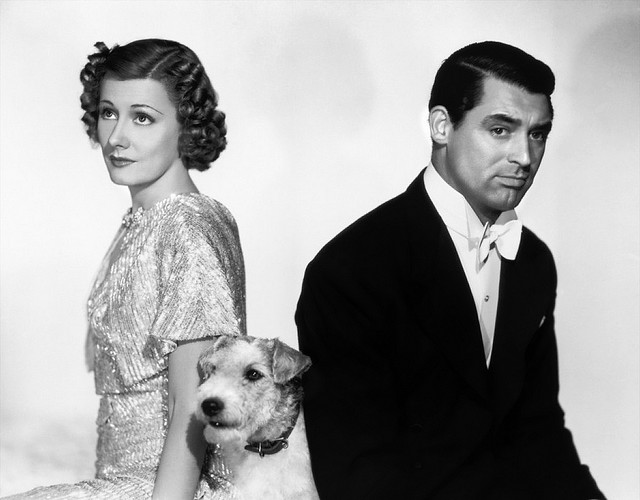In general, screwball comedies epitomise Bergson’s definition of the comical: a certain “materiality that succeeds in fixing the movement of the soul”, that is opposed to grace and manifestly out of sync with the prevailing order of society and the normal functioning of human body. A typical example for this is the slipping on a banana peel, which occasions a disturbance of a flexible and continuous body movement and its harmony with the environment. Once repeated, this incidental moment of hilarity persists, but insofar as its oddity comes to be asserted as the new order, the laughter may more or less cease. It is thus an imperative with screwball comedy to negotiate and maintain a balance between surprise and repetition, although, admittedly, in terms of the genre’s distinction from other forms of comedy, what makes its “screwball” is also its capacity for and inclination towards overemphatic effects, which are less calculated to elicit laughter than to censure or survey the absurdity of everyday life.
Leo McCarey’s The Awful Truth (1937), widely known as one of the greatest achievements of its kind and in the director’s extensive career, reverses somewhat the time-honoured formula by centring the narrative progression on the returning from a latent and ill-judged assimilation to normality to the natural elements of alterity. Lucy and Jerry, a couple to whom a shared propensity for joke is as much a benefit to their union as it is, indeed, its hidden threat, settle for a spontaneous divorce after apparently catching each other in extramarital relationships. The story hereafter concerns with their attempting to justify and to move past that rash decision, to acclimatise to a new life still periodically haunted by each other’s “untoward” presence, and to repair the damage after realising the “awful truth”.
It was known that both Irene Dunne and Cary Grant were initially unhappy with McCarey’s heavy reliance on improvisation, which gives the finished film a discernibly haphazard look which, on the whole, works surprisingly well. The use of episodic device relieves the burden of systematising the plot line and is as such able to sustain its appeal amongst the audience even when the story itself lacks substance and unity. McCarey was especially adept at crafting the evocative atmosphere for a given situation, whereas character study was evidently not his strongest suit. Thus Lucy and Jerry fail to register as enduring and remarkable an impression as, say, Nick and Nora Charles of The Thin Man (1934), but this is sufficiently recompensed by the magnetic dynamism between the actors. With the casting of Dunne, who until then had not done much comedy - Grant recalls in an interview that Dunne would often whisper to him, “Funny?”, after a take -, McCarey showcased his Bergsonian touch by underscoring the incongruity of a genteel lady like Dunne doing slapsticks and playing a flighty woman. In fact, Dunne’s character appears, of the pair, to be carrying most of the dramatic weight throughout; she is also the one who, in a barefaced honesty that might be considered risqué of her time, declares not long after the couple’s separation, and in anticipation of her new beau’s proposal, that she is still in love “with the crazy lunatic.”
The winsome pairing of Dunne and Grant led them to work together on two more films: My Favorite Wife (1940), with Garson Kanin as director and script co-written by McCarey, which contains similar scenarios of the wife posing as the estranged husband’s relative to dupe his fiancée, and a final reconciliation preceded by delightfully suspenseful moment with the couple, in separate bedrooms, waiting for the other to, in reference to a motif in It Happened One Night (1934), tear down the “wall of Jericho”; and George Stevens’s three-hankie weepy, Penny Serenade (1941). McCarey’s entrenched Catholicism, which rendered many of his films rather facile testaments to the virtue of marriage, was resolutely kept at bay in his passion project, also featuring Dunne and Grant but in separate films: the former with the enigmatic and suave Charles Boyer in Love Affair (1939), the latter paired with a slightly theatrical Deborah Kerr in the remake, An Affair to Remember (1957).

Comments
Post a Comment